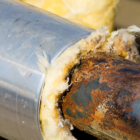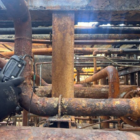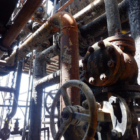In the aftermath of a fire incident, asset owners face the critical challenge of evaluating the extent of damage to their equipment and determining the best course of action for restoration and repair. Inaccurate or insufficient evaluation can have severe consequences, ranging from reduced productivity to catastrophic failures endangering the environment and human safety. As leaders in the NDT and asset management industries, TechCorr understands the crucial importance of comprehensive, methodical inspections in such situations. By employing cutting-edge non-destructive testing (NDT) methods, adhering to strict industry guidelines, and leveraging data analytics expertise, TechCorr helps clients navigate the challenges of post-fire asset evaluation and ensures the integrity of their machinery.
The Challenge: In a recent case study, TechCorr was called upon to assess the condition of a horizontal drum vessel following a fire incident. The company’s team of certified technicians conducted a comprehensive external API 510 Compliance inspection, utilizing ultrasonic thickness measurements at strategically selected Condition Monitoring Locations (CMLs) to evaluate the vessel’s structural integrity. Visual inspections revealed significant coating damage and burned gauges, but further investigation was necessary to identify any hidden damage that could compromise the vessel’s performance and safety.

To fully understand the vessel’s condition, TechCorr conducted comprehensive metallography and hardness testing on both the fire-affected and undamaged regions. The company’s engineers carefully examined the grain structures and mechanical properties, verifying that the vessel’s metallurgical structure had not been significantly damaged despite the severe heat exposure. This thorough examination provided the asset owner with crucial information about the overall condition of the vessel, enabling well-informed decisions regarding maintenance, repairs, and future operations.
Beyond the application of advanced NDT techniques, TechCorr’s methodology included a comprehensive Fitness-for-Service (FFS) evaluation. The team assessed the vessel’s structural integrity in light of the fire incident and the remaining wall thickness. Based on these findings, it was concluded that the vessel could be operated as long as regular maintenance procedures and inspections were followed. Additionally, the comprehensive assessment laid the foundation for a long-term asset reliability and risk reduction plan.
TechCorr’s post-fire inspection process goes beyond merely identifying damage. The company provides clients with comprehensive guidance on maintenance, repairs, and ongoing surveillance, ensuring that their assets continue to operate safely, efficiently, and in compliance with industry standards. In this case, TechCorr recommended recoating the vessel, replacing any damaged components, strengthening the support structures, and performing a hydrostatic test to confirm the vessel’s integrity. Through the implementation of these steps and adherence to a comprehensive inspection plan, asset owners can operate their equipment with confidence, even when faced with unforeseen challenges arising from fire incidents.






